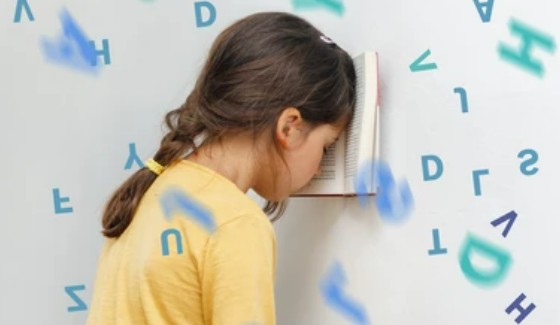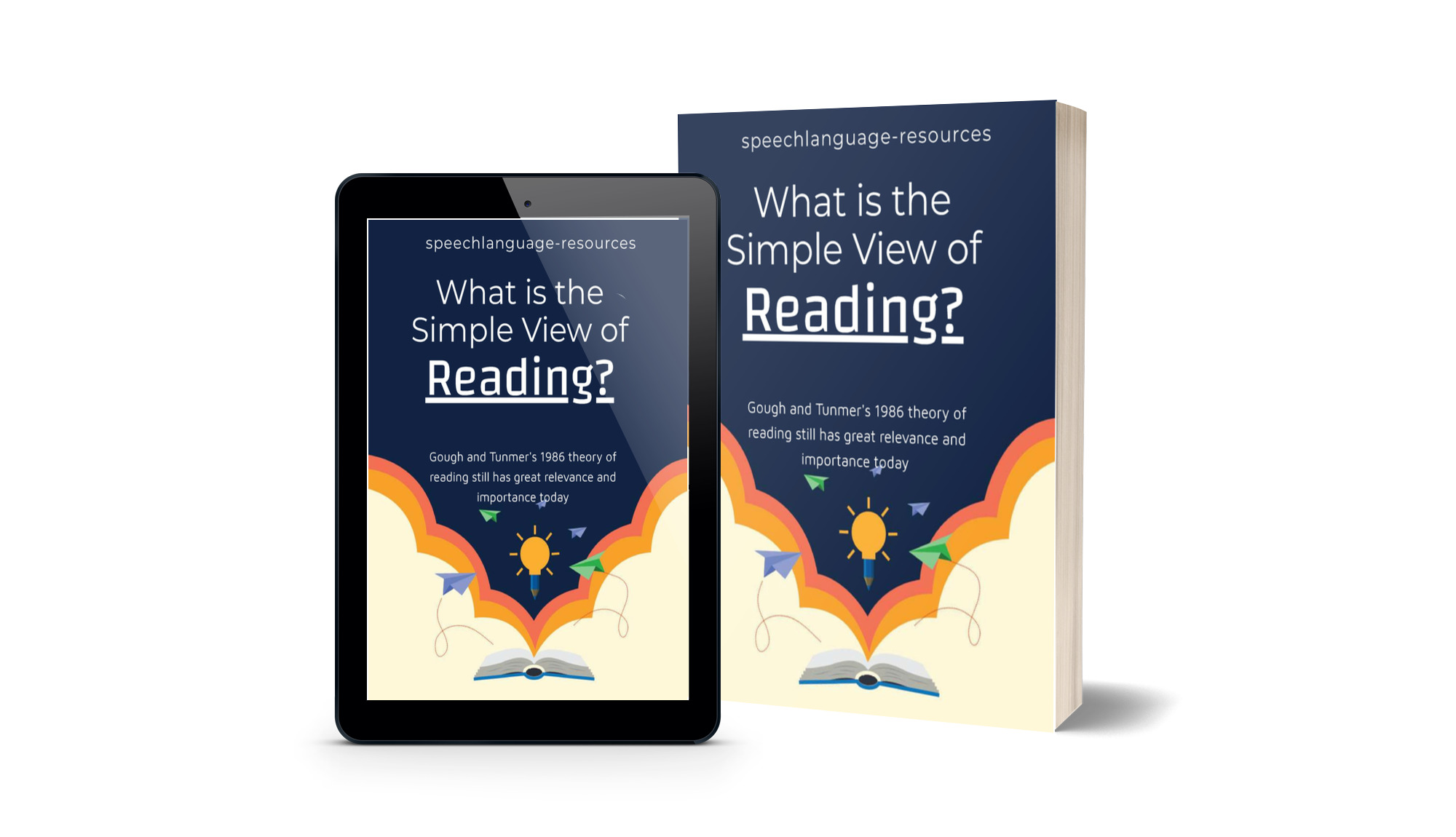Simple View of Reading

The Simple View of Reading is a scientific theory of reading that was offered to the education world in 1986 by Philip Gough and William Tunmer.
Education institutions at that time were in thrall to the Whole Language philosophy and its whole word teaching method. Educators had little interest in a reading model that positioned decoding as being the best way to teach reading. Professor Pam Snow states that for many teachers ‘the Simple View of Reading was a gift that went missing in the mail.’ (Snow, 2019)
Yet, the Simple View of Reading endures, particularly in reading science circles. Its central thesis is that reading comprehension is the product of decoding ability and language understanding. This core concept remains highly influential. (Mark Seidenberg in Language at the Speed of Sight 2017, states that Phillip Gough is being a little coy with the use of the word simple, and that the simple view actually reveals a deep insight about how we learn to read.)
The model is constructed from three variables...
R = D x C
R is for Reading Comprehension, D is for decoding, C is for language comprehension.
Simple View of Reading: The Equation and its Importance
Note that the multiplication symbol x is used. The variables in the Simple View of Reading must be multiplied, not added together. So, successful reading = decoding x comprehension, or reading = 1 x 1.
True reading comprehension results from both successful decoding and comprehension of written text. The perfect 1. Decoding and comprehension are independent of each other, but a score of 0 in either can only lead to reading failure.
Let me explain…
Think of the Simple View of Reading as number symbols:
R = D x C becomes…
1 = 1 x 1
In the Simple View of Reading, 1 is the target, the ideal score. Yet, if by mistake we add the scores together instead of multiplying, the equation changes.
1 + 0 = 1.
0 + 1 = 1, etc.
We always end up with 1, the ideal score. So addition is of no use here.
But, if we replace the + symbol with the multiplication symbol x, the equation changes.
1 x 0 = 0
0 x 1 = 0
0 x 0 = 0
1 x 1 = 1
These basic equations are at the heart of the Simple View of Reading. The examples listed are at the extreme ends of the equation: 0 = null, 1 = perfect, and should be considered a guide only.
So, for our purposes, if one of the components of reading, either decoding or comprehension, is 0, reading failure is the outcome. If both decoding and comprehension are 0, again, reading failure is the outcome.
For instance, if a child has good decoding but poor comprehension. The equation may look like this…

For a child who has good comprehension but poor decoding ability the equation may look like this…

For a child who has both poor comprehension and poor decoding the equation may look like this…

For a child with good decoding and good comprehension the equation may look like this…

Gough and Tunmer refer to two distinct types of comprehension: language comprehension and reading comprehension. Stephen Parker makes the point that to avoid confusion we should add the C to the R (RC – reading comprehension) and an L to C (LC – language comprehension). (Parker, 2019)
We will do the same here.
RC = D x LC
Reading Comprehension = Decoding x Language (listening) Comprehension.
Language comprehension involves being able to hear and understand spoken language. Reading comprehension is the end result of successful decoding and language comprehension. Put simply, the text a child decodes has to be understood by the child for reading comprehension to take place. Reading comprehension is reliant on a child’s decoding and language comprehension abilities.
Simple View of Reading: Successful Reading Comprehension
Gough and Tunmer state that the most efficient path to reading comprehension success is for early years children to be taught decoding to a level of mastery.
‘Mastery in early decoding leads to skilled reading. As readers become more proficient, they progress from sounding out each word to recognizing words instantly. ‘ (Parker, 2019)
Decoding skill is being able to interpret the print symbols on the page to speech sounds. Solid decoding skill enables children with strong language comprehension to competently access and understand age appropriate text. The result is reading comprehension success.
RC = 1 (D) x 1 (LC)
Children with this profile are well on their way to academic success and have made the critical shift from learning to read, to reading to learn.
Simple View of Reading: Reading Difficulty

Many children enter the school system with solid oral language skills. They understand others’ speech well and can communicate their own wants and needs. In short, most children start their school lives with the necessary oral language skills to read and comprehend text well.
And yet for many students attaining reading mastery is heart-wrenchingly difficult. The breakdown often occurs because children do not have the skill to accurately sound out and decode unfamiliar words.
The flow-on effect is years of reading struggle. This impacts students’ ability to access text and to engage in reading to learn activities. The simple view equation for children who are poor decoders is that they cannot reach the level of 1: reading comprehension success.
Poor decoding directly affects reading comprehension. Children simply fail to comprehend what they cannot decode.
Let us look at an example of how decoding affects comprehension.
A grade 3 boy, 9 years of age, has solid oral language skills but has always been poor at decoding. The child is to read a passage of 200 words, where let’s say, 15 of the words are 3, 4 and 5 syllable multisyllabic words.
What is the Simple View of Reading FLIPBOOK
The child is unable to decode unfamiliar words, particularly multisyllabic words. The boy makes a floundering attempt to guess each of the unfamiliar 15 words, incorrectly in each case.
At other times, the child bravely forges ahead while reading the passage. He makes no attempt to guess troublesome words at all, just leap frogs them like a gazelle. He hopes to get the gist of the passage by guessing the meaning of each section. Yet the lost 15 words were critical to understanding the passage.
The child was able to recognize many single syllable sight words in the passage. There are even 2 syllable words that through rote memorization the boy has learnt to recognize. Yet, because of an inability to decode unfamiliar words, the boy could not decode the 15 key multisyllabic words and thus was unable to understand the passage as a whole. The result is reading comprehension failure.
Download the free ebook, which contains a revised version of this article in portable form.
Click on image to download What is the Simple View of Reading? as a PDF file.
Simple View of Reading: Poor Language Comprehension
Children with fluent decoding can have reading comprehension difficulties. This can be a result of developmental language impairment, or because of an underlying cognitive difficulty.
Children from disadvantaged backgrounds can also begin school with an oral language delay. This can affect a child’s vocabulary development and understanding of complex language. A child with this profile may be able to decode unfamiliar text, but may struggle to understand extended complex passages.
The simple view equation for this might be RC = 1 (D) x 0 (LC). Once more, reading comprehension failure is the result.
Children with developmental oral language disorder often have a general reading disability. They can neither decode nor understand much of what they can decode. A significant language difficulty can be as devastating on decoding skills as it is on reading comprehension.
Simple View of Reading and Reading Instruction

In their 1986 article, Gough and Tunmer made the case that decoding should have a prominent place in reading instruction.
‘If decoding plays a central role in the reading process, then it seems sensible to give it a comparable place in instruction…It might well be that direct instruction in Synthetic Phonics is the fastest route to skilled reading.’ (Gough and Tunmer, 1986)
The Simple View of Reading informs many evidence-based, best practice methods of reading instruction.
Modern synthetic phonics teaching methods found in successful programs such as Multilit, Sounds-Write, Jolly Phonics, etc, have their theoretical roots in the Simple View of Reading.
Simple View of Reading: Conclusion
The Simple View of Reading is a falsifiable theory. That is, the theory was put into the public arena for others to disprove. Since 1986, the Simple View of Reading has been tested in over 100 studies. The studies have examined not just reading disability with school-aged children, but also adults, readers with typical reading skills, and readers with oral language difficulties.
Reading research supports the authors’ original view that reading comprehension is a result of good decoding and oral language skills.
In a recent review of the Simple View of Reading academics Anne Castles, Kathleen Rastle and Kate Nation stated that the Simple View of Reading got it mostly right. ‘The logical case for the Simple View is clear and compelling: Decoding and linguistic comprehension are both necessary and neither is sufficient alone. A child who can decode print but cannot comprehend it is not reading; likewise…reading cannot happen without decoding.’ (Castles, Rastle & Nation, 2018)
The Simple View of Reading is an original and insightful theory. It proposes that reading comprehension is the product of decoding and language comprehension. Neither alone is enough for reading comprehension. Reading comprehension is completely reliant on both decoding and language comprehension.
References
Castles, A., Rastle, K. & Nation, K. (2018) Ending the Reading Wars: Reading acquisition from novice to expert, Psychological Science in the Public Interest, 19, 5–51.
Gough, P.B. & Tunmer, W.E. (1986) Decoding, reading, and reading disability. Remedial and Special Education, 7, 6-10
Kamhi, A.G. & Catts, H. W. (2012) Language and reading disabilities 3rd Edition, Pearson
Moats, L.C. (2010) Speech to Print: Language Essentials for Teachers Paul H Brookes Publishing Company
Parker, S. (2019) Guest Post: The Simple View of Reading: Still Conclusive after 33 Years, The Snow Report, Pam Snow. http://pamelasnow.blogspot.com/2019/02/the-simple-view-of-reading-still.html
Seidenberg, M. (2017) Language at the speed of sight: How we read, why so many can’t, and what can be done about it Basic Books, New York
Tunmer, W.E. & Hoover, W. A. (2019) The cognitive foundations of learning to read: a framework for preventing and remediating reading difficulties, Australian Journal of Learning Difficulties, 24:1, 75-93
The Simple View of Reading, Wikipedia, Wikimedia Foundation, Last edited 19 May, 2020
https://en.wikipedia.org/wiki/Simple_view_of_reading
Updated 10/2023

